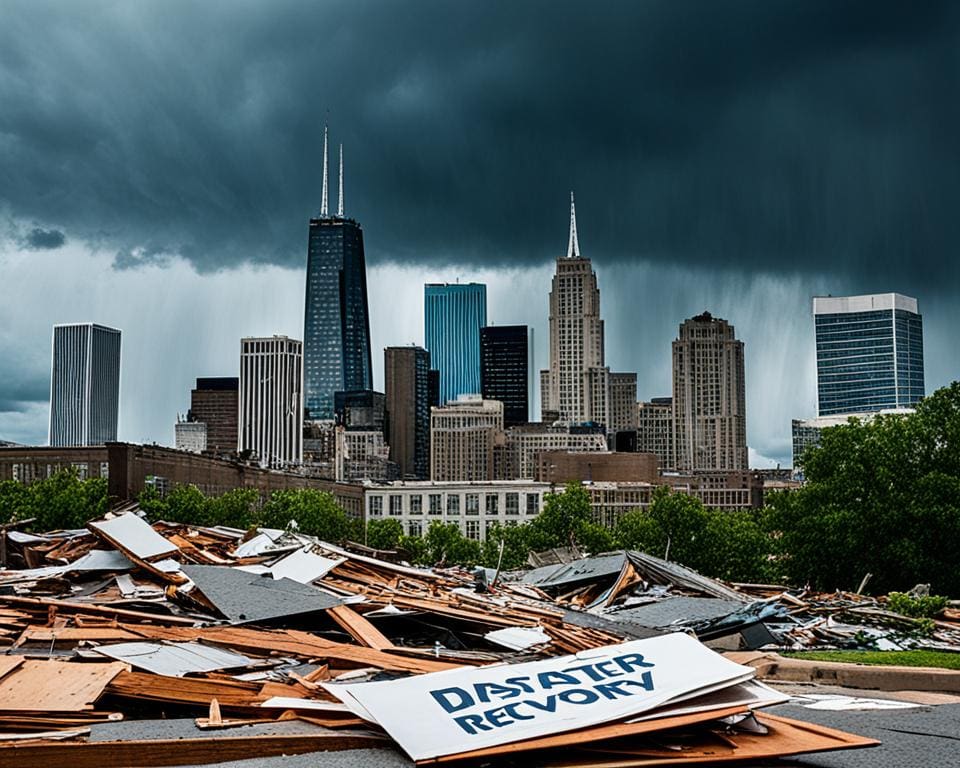In today’s fast-paced world, having a good disaster recovery plan is key. Businesses of all sizes need to be ready for things like natural disasters, cyberattacks, or tech failures. It’s crucial for a business to have a disaster recovery strategy.
Without a strong plan, the risks are high. Data could be lost, work could slow down, and you might even face fines. Over half of the companies hit by a major disaster might not make it if they’re not prepared. A good plan covers steps to prevent, detect, and fix problems quickly.
With more companies using the cloud, being prepared for disasters is more important than ever. A smart disaster recovery plan helps keep business running smoothly. It protects important info and makes sure a business meets rules and standards. This helps a company stay strong through unexpected challenges.
Understanding the Importance of a Disaster Recovery Plan
A comprehensive disaster recovery plan is a must for any business. It’s key for dealing with unexpected challenges. This plan is crucial for keeping operations going and protecting important assets. It helps organizations bounce back quickly and reduce downtime after unforeseen events.
Minimizing Downtime
Without a disaster recovery plan, businesses could face long downtime after a disaster. This can lead to big revenue losses and unhappy customers. Implementing effective strategies helps cut downtime. It allows quicker service restoration and protects profits. Regular testing of these strategies ensures the team is ready. It also spots weaknesses before real crises hit.
Data Protection
Data backup is critical in the digital world. Without good backup processes, businesses risk losing important data forever. This includes financial records and customer information. Following the “3-2-1 rule” for data backup is smart. It means creating three copies of data, storing them in two different places, with one kept offline. This approach keeps crucial information safe and builds trust with customers. They expect their data to be protected well.
Compliance with Regulations
Many industries must follow strict disaster recovery rules. Businesses need to match their recovery plans with these rules to avoid fines and legal issues. Meeting these standards not only helps protect data. It also boosts a company’s reputation with clients and partners. This keeps them competitive in their field.

Why Every Business Needs a Solid Disaster Recovery Plan
In today’s world, businesses face many threats that can stop their work. These range from natural disasters to cyberattacks. It’s crucial for every company to have a solid disaster recovery strategy. Instead of asking if a disaster will happen, companies should prepare for when it strikes. This proactive stance helps reduce risks and keeps things running smoothly.
The Reality of Potential Disasters
All businesses risk facing issues that can interrupt their services. Without a good disaster recovery plan, the consequences can be severe. Having backups of data is vital. It helps businesses quickly restore their systems and important info if needed. Also, working with a Managed Service Provider (MSP) boosts planning for business resilience. These pros check the current setup, spot risks, and suggest backup options that fit the business’s needs.
Enhancing Overall Business Resilience
Getting ready for disasters is more than just meeting rules; it’s a chance to make operations stronger. A clear disaster recovery and backup plan lessens the hit from unexpected events. It keeps key services up and running. Small businesses gain from professional IT help. This ups their productivity and security, even though starting costs seem big. The benefits and financial security down the road are worth it.
Using backups stored off-site reduces risks linked to storing everything in one place. Cloud backups offer flexible choices, so companies can pick the storage size they need without spending a lot. Virtual disaster recovery promises very fast return times. Even though it needs a lot of resources to keep up, it’s a good choice.
Best Practices for Disaster Recovery Planning
Creating a good disaster recovery plan is crucial for keeping your business safe. First, doing a deep dive to figure out risks is key. This step helps figure out what dangers could stop your business from running. Since 96% of business chiefs say they’ve faced problems recently, knowing these risks helps plan better.
Using cloud tech for disaster recovery is now a top pick. It’s flexible and doesn’t cost too much. Cloud solutions make sure your data is backed up safely and helps get your business back up fast. Making sure to check and update your disaster plan regularly is also critical. Try to test your plan 2 to 4 times a year to find and fix any issues.
Getting everyone involved in planning for disasters is vital. It’s important that each person knows what to do if things go wrong. By focusing on risk checks, regular tests, and working together, your business can bounce back quicker from any issue. In the end, these steps don’t just protect your information. They also make your company stronger and more focused on facing challenges.









